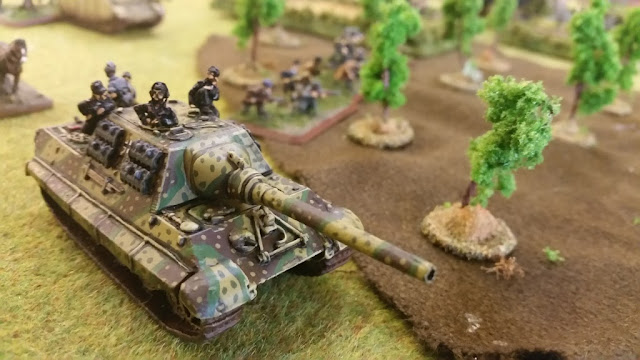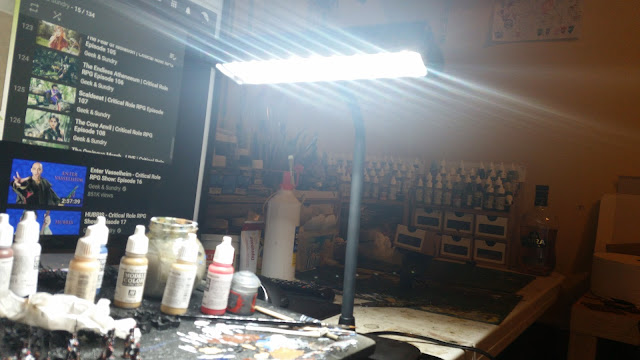The top ten reasons why I play Battlegroup WW2 Rules
10. Scaleability.
Battlegroup's system allows you to play with whatever troops you have within whatever time you have.
All you need is 6ft by 4ft table upon which you can play any of the four game sizes within the system Squad, Platoon, Company or Battalion level games.
The bigger the game type the longer the game, the sweet spot for us is 15mm Company size games which play out in about 6 hours either at home or at the local club. We suggest the bigger the game the smaller the choice of figure scale to avoid having to add more table area.
 |
| Jack and Liam prepare for battle at Tyneside Wargames Club, often we play at home. |
9. Quality of Product.
The theatre books are sheer class, a wonderful blend of pocket history guide, hobby tips and army lists.With distinctively clear branding, high production value in the actual physical product and unrivalled miniature photography, the books are truly excellent.
8. Its not really IGOYOUGO.
I like a game that makes things difficult for the commander.Sure, RAW states I have my turn then you have yours. But a few games in you realise that the key to a good game is using the two orders that activate in the enemy turn- Ambush fire (aka Overwatch) and reserve move. Also the chit system means that every time a unit is lost there's a 50/50 chance of a random event and they can bounce around the table like wildfire, making the game anything but predictable.
7. Army lists.
The army lists in each theatre book allow us to pick an army that reflects a Battlegroup on any given day in that sector during that period.The subtlety and depth here is brilliant. Its like supermarket shopping; You buy a few staples from the meat and veg counters then spend what money you have left in the wine and chocolate sections on your way out. This makes each game different and allows you to use each and every toy in your collection at some point.
6. The "re-roll to aquire target for second aimed shot" rule.
I love this rule but new players often baulk at it until they understand the reasoning behind it. Educate them and enjoy the look in their eyes when it "clicks".I can paraphrase it thus - "Stuff dives for cover when its shot at" or "Smoke and dust happens when you shoot".
There is now a full page explaining the reason for this in the latest ruleset which helps to explain it. Read that page first, if you don't like it or fail to get the whole "ethos" of the rules on that page then put the book down, walk away and we will agree never to speak of these rules again.
5. Community support.
The game has a thriving, responsive and positive community.
4. Several distinctive theatrical flavours, aka "feel".
There are several Theatre specific books on offer, each with a very different feel due to specific army composition and special rules.All WW2 battles shouldn't feel the same; The dilemmas faced by commanders in different theatres should be similar in nature but terrain, doctrine, communications, supply, troop quality and troop quantity will be influencing factors and the Theatre-specific books do a great job of recreating that through their quirks and special rules.
Playing '41 Russia feels so different from Berlin '45 for example.
3. Common sense and real tactics work.
These rules are firmly defined by common sense for historical gamers not competition gamers.Units behave realistically and command and control is king. Armies play differently depending on period and nationality which keeps it fresh and if you use historical tactics you should do well.
2. Battle Rating System.
The BR system makes every game end in a crescendo as you try to denude the enemy points to zero whilst preserving your own.I can't say any more than every game we have played (and thats a lot) has ended on a knife edge.
1. Narrative.
Every dice roll contributes to the game narrative. We enjoy embellishing the story as we play, describing why the random event chits occur or why my crack force only got two orders this round.The rules allow us to tell a story in great detail, units develop personality and the scenario planner ensures a challenging, fun and realistic experience every time.



















To get into it, what books do I need? I have Brit paras and regular Heer forces and terrain painted up and intended for Normandy from D-day
ReplyDeleteFor Normandy, the Overlord book is used. It's "beyond the beaches" part is now in a reprint. But it "only" has the army lists for after D-day. The lists for D-day (like amphibius assault forces) aren't in it. For British (the forces I play) it has an infantry and an armoured group list. Saddly no paras.
DeleteYou could also use Greg Farrell's Battlegroup Builder (http://gregfarrell.org/builder/bgb.html). Though no longer being updated, it does include the D-Day Overlord lists.
DeleteYou can start with the Rulebook and see if you enjoy it, theres a mini Canadian/ SS campaign in it which you can read through. luckily for you the Arnhem Book is coming out very soon when you will be able to use your paras. As suggested, if you can get hold of the original Overlord book (out of print) then you can start playing with that too. Check out the Guild forum too.
ReplyDeleteYou can get the 6th Airborne army list on this online army builder too. Its unofficial but very good. http://gregfarrell.org/builder/bgb.html
All good points, though (1), (2), and (3) ring especially true I think.
ReplyDeleteCdlT
Glad you enjoyed it
DeleteI had the Kursk book and stupidly sold it - now it seems a lot of books need to be bought to play the various theatres that interest me.
ReplyDeleteStart with the new rule book and see if it bgrabs you. The books atleast hold their value it seems if not go up. ThatKursk book sells for silly money now. I bought the digital download last week as its out of print.
DeleteThank you, I have 28mm figures for the Brit Para and HEER, and then 6mm figures for the Eastern front 1941-43 so keen on seeing how the rules tranlate between Platoon to Battalion size games
ReplyDeleteLate comment, but regarding point 6 and “ There is now a full page explaining the reason for this in the latest ruleset which helps to explain it.” Which page is that (and which rulebook edition), as I can’t find it anywhere?
ReplyDeleteAh, found it, never mind
ReplyDelete